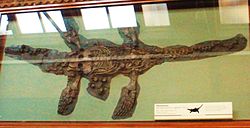| Eretmosaurus Temporal range: Early - Middle Jurassic,
| |
|---|---|

| |
| Neotype specimen of E. rugosus | |
| Scientific classification | |
| Kingdom: | Animalia |
| Phylum: | Chordata |
| Class: | Reptilia |
| Superorder: | †Sauropterygia |
| Order: | †Plesiosauria |
| Superfamily: | †Plesiosauroidea |
| Family: | †Microcleididae |
| Genus: | †Eretmosaurus Seeley, 1874 |
| Type species | |
| †Eretmosaurus rugosus Seeley, 1874
| |
| Other species | |
| Synonyms | |
| |
Eretmosaurus (meaning "oar lizard") is an extinct genus of plesiosaur from the Early and Middle Jurassic of England and Russia.[1][2] Two species are known: E. rugosus and E. dubius.


The holotype of E. rugosus has no known recorded specimen number[3] and it consists of vertebrae, girdles, and limb bones discovered in Granby, Nottinghamshire where the Asteroceras obtusum zone of the Lower Lias Formation outcrops.[4]
Specimen BRSMB Cb 2458 was also assigned to the species by Owen (1840).[5] This specimen later became the syntype and it consisted of several vertebrae that had been discovered at different locations in the Blue Lias Formation in Gloucestershire across Aust Cliff.[3]
Owen (1840) was the first to describe the specimens, which were named as Plesiosaurus rugosus.[5] Later, Owen (1865) described a headless skeleton discovered in the Ammonites stellaris zone of the Blue Lias at Granby, Nottinghamshire (NHMUK 14435) that he assigned to P. rugosus,[6] and Seeley used NHMUK 14435 as the basis for naming Eretmosaurus rugosus in 1874.[7]
As BRSMB Cb 2458 was not diagnostic and was lost by 1940, a petition was filed with the ICZN over the holotype by Brown and Bardet (1994),[1] and NHMUK 14435 was allocated as the official neotype in 1996.[8]
A fragmentary specimen of Eretmosaurus rugosus has also been identified from the Middle Jurassic of Siberia by Menner (1992).[2]
A partial skull and skeleton belonging to a plesiosaur was discovered in the Harpoceras faleifer zone, Whitby, England[3] and it was initially described by Blake & Tate (1876) as a species of Plesiosaurus known as P. dubius. It was later reclassified as a species of Eretmosaurus by Blake in Blake & Tate (1876).[9]
Benton and Spencer (1995) mentioned a third species of Eretmosaurus: E. macropterus; they rectified this mistake within the same paper by mentioning on page 116 that E. macropterus actually belongs to Microcleidus.[4]
Eretmosaurus was classified into Rhomaleosauridae by Persson (1963),[10] then into Pliosauridae by Brown (1981),[11] then into Elasmosauridae by Bardet (1995)[12] and Bardet et al. (1999),[13] and most recently into Microcleididae by Benson et al. (2012).[14]
{{cite book}}: ISBN / Date incompatibility (help)